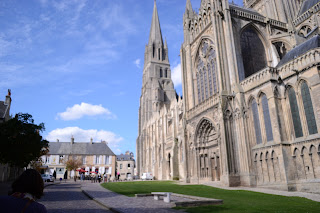Sacre bleu! Almost two weeks without a blog - not that we've been resting on our laurels. Oh, where to begin...
We've covered a lot of Norman territory, and I must insist that readers take some time to look over our flickr photos of Normandy. A lot of work has been put in on our part to streamline the photo-viewing process, and from now on every photo we upload will appear in http://www.flickr.com/photos/jakeandmary, organized by set. Mary has painstakingly taken the time to type up descriptions for most of them, should anyone wonder where they were taken and what's going on.
Anywho, without further ado:
One fine weekend Jon took us to a fair. That's where I snapped this lovely candid pic of Mary enjoying a bratwurst and a Kronenbourg 1664 (not my favorite French beer). Touring around France has left me with numerous opportunities to sample the local flavor, and in this case I mean alcohol ("d'alcool" to the French). We weren't able to leave the fair without picking up bottles of locally-distilled cognac and locally brewed hard cider. In Southern France, we were treated (or made victim) to "l'eau de vie" - the water of life. Whatever it was, it burned hotter than Satan's hoof on the way down! In Normandy, there is an abundance of apples ("les pommes"). Therefore, the local Norman drinks consist mainly of cidre (hard cider), pommeau (an apple liqueur), and Calvados (a distilled apple-brandy).
One day we made our way to Bayeux, where we were able to enjoy galettes. These are more savory versions of crepes, though I admit they are no less ripe with calories.
Bayeaux would hardly be a French city without a cathedral reaching up toward the heavens, so here it is. Just outside the building, an old Roman wall can be viewed with sections dating back to the third century. However, the real jewel of Bayeux is its famous tapestry which dates back almost a millenium. We visited it, but were not allowed to take pictures. The piece of needlework, which is over 200 feet long, describes The Battle of Hastings (1066) where William the Conqueror slew the traitor-king, Harold.
On our way out of Bayeux toward the train station, we happened upon the British cemetery dedicated the invasion of Normandy. These sorts of memorials are abundant in the region and serve as sobering reminders of the war that once ravaged this beautiful part of France. This was apparent again when our train had a layover in St. Lo. The cathedral stood with only one of its two bell towers, and inside was a sort-of museum explaining how most of St. Lo was reduced to ruin by German and American artillery.
We bided our time back at Le Castel for about a week before venturing out again, in part because the van which provided our transportation fell into disrepair.
One day we made our way to the train station with a little help from a friend of Jon's. We set a course for the beautiful seaside village of Honfleur, at the mouth of the Seine, with no real schedule in mind. A train brought as as far as Deauville, across the street from Trouville. Traditionally, Deauville has been the preferred maritime getaway for the Parisian jetset. Trouville was established by some relative of Napoleon III as competition to Deauville. After wandering around a bit, we decided to stay the night, and continue to Honfleur the following day. Oh, by the way, the above photo may surprise some once they realize it's someone's home, complete with drawbridge and everything.
This photo was taken of the harbor in Honfleur, where we arrived in the morning via bus. We were lucky enough to arrive during some sort of yacht race. Amongst a few other distractions, Honfleur is home to the very eccentric museum of French composer/pianist Erik Satie.
Also while in Honfleur, we signed up for a boat tour of the Pont de Normandie, a large suspension bridge which spans the Seine to connect Honfleur to the much more industrial town of Le Havre.
After spending the night in Honfleur, we awoke and took a bus to Caen, the capital city of Normandy.
We didn't stick around for long in Caen - we were tired and our feet hurt, but that wasn't going to stop me from exploring a special exhibition on Viking history. For the uninformed, Normandy is so named for the Normans, a viking people who settled there over a millenium ago. After the viking museum, we went home.
Long hours have been spent reading eBooks and sipping on cider by the fire at Le Castel. Sometimes, life really is too hard...
Kylie (left) and Robbie (right), Burmese siblings, try their hardest to love and be loved. The reality of it is that they make me dearly miss my little black cat in America, Penelope.
This is the top floor of our gîte, a French country cottage. It felt unbelievable to be able to unpack our bags after living out of them for over a month.
As usual, if anyone would like to see more of our trips, don't hesitate to take a look at our flickr photoset of Normandy. While you're at it, why not sneak a peak at our photos of Southern France and London & Paris (now with detailed captions, thanks again, Mary).
In our next blog, Mary will cover our trip to the immaculate Mont Saint Michel.
-Bon journée, Jake












No comments:
Post a Comment